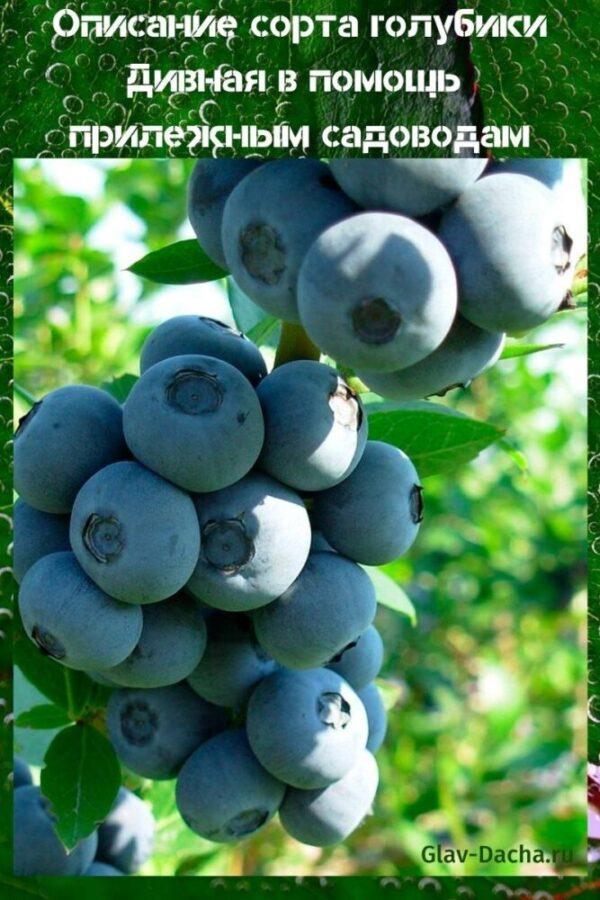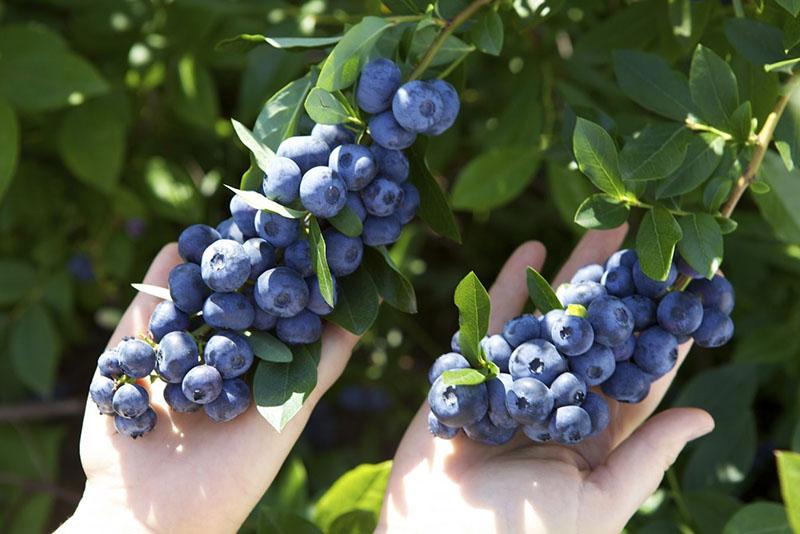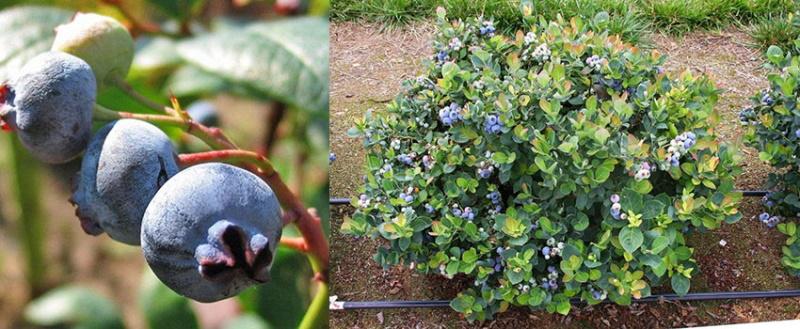Description of the Blueberry variety Divnaya to help diligent gardeners
 A distinctive feature of the variety is the dense arrangement of berries on a branch. Also, the description of the Divnaya blueberry variety includes the excellent frost resistance of the culture. It has been experimentally proven that the plant can withstand temperatures down to -42˚С. In addition, many gardeners value the shrub for its good yield. Up to 0.7-1.6 kg of juicy fruits are harvested from one medium-sized bush. At the same time, the crop has excellent immunity to most common diseases and pests. However, there are other features of the gonobel.
A distinctive feature of the variety is the dense arrangement of berries on a branch. Also, the description of the Divnaya blueberry variety includes the excellent frost resistance of the culture. It has been experimentally proven that the plant can withstand temperatures down to -42˚С. In addition, many gardeners value the shrub for its good yield. Up to 0.7-1.6 kg of juicy fruits are harvested from one medium-sized bush. At the same time, the crop has excellent immunity to most common diseases and pests. However, there are other features of the gonobel.
Detailed description of the blueberry variety Divnaya

Paying attention to the description of the Divnaya blueberry variety, all parts of the plant deserve detailed consideration:
- Bush. It grows up to 40-60 cm in height, therefore it belongs to the medium-sized.
- Shoots. The branches are slightly spreading and erect, often curved. They have a matte bark without pubescence, colored in a light brown shade.
- Leaves. Leathery, matte
- deciduous plates of deep green color. Mostly medium-sized wedge-shaped with a convex center.
- Flowers. Buds are formed on short clusters of 1-2 or 3-5 pcs. The flowers are quite large, bright pink. The budding period falls on May-June.
- Fruit. Berries (weight 0.6-1.1 g) have an irregular oval-rounded (flattened at the poles) shape with light edges. As they ripen, they acquire a dark blue tint with a slight bluish bloom. The taste is sweet, but with a predominant sourness.
The description of the Marvelous Tall blueberry variety should include the fact that the culture gives many young shoots. For this reason, the shrub is in dire need of seasonal pruning.
 The seedling begins to bear fruit in the 3rd year after planting. The berries ripen together, almost simultaneously. The harvest, which is always regular, regardless of weather conditions, falls on the end of July or the beginning of August. Due to the rather thin skin, the transportability of the berries is very low. Often, during long-term storage or long-term transportation, overripe fruits crack. Among the advantages of the variety are its self-fertility, as well as large-fruited. The variety has unique beneficial properties, since the fruit contains a "decent" percentage of vitamin C (44.6%). Also, experts note the high content of tannins, pectins, flavonoids and anthocyanins in gonobel.
The seedling begins to bear fruit in the 3rd year after planting. The berries ripen together, almost simultaneously. The harvest, which is always regular, regardless of weather conditions, falls on the end of July or the beginning of August. Due to the rather thin skin, the transportability of the berries is very low. Often, during long-term storage or long-term transportation, overripe fruits crack. Among the advantages of the variety are its self-fertility, as well as large-fruited. The variety has unique beneficial properties, since the fruit contains a "decent" percentage of vitamin C (44.6%). Also, experts note the high content of tannins, pectins, flavonoids and anthocyanins in gonobel.
The ABC of growing blueberry varieties Divnaya
 In the natural environment, the shrub plant grows in swampy areas and in the shade of large trees. For this reason, farmers recommend planting crops in partial shade, but with sufficient access to sunlight in the morning / evening hours. At the same time, the territory must be protected from wind and drafts.
In the natural environment, the shrub plant grows in swampy areas and in the shade of large trees. For this reason, farmers recommend planting crops in partial shade, but with sufficient access to sunlight in the morning / evening hours. At the same time, the territory must be protected from wind and drafts.
For dove, soil is suitable with the following features:
- loose;
- acidic (4-5 pH);
- sandy loam, peat or peat-sandy.
The best time to plant this variety is in spring.Unlike autumn planting, spring planting allows the shrub to take root well before the onset of frost.
Loamy soil is not suitable for growing Divnaya blueberries. If there are no other options, then such a site must be entered high peat, as well as coniferous litter (branches, needles, bark and cones). A good drainage system is formed at the bottom of the planting hole. The "pillow" is made of stones (10-15 cm), in order to avoid stagnation of water, which means decay of the rhizome.
Depending on the type of soil substrate, planting agrotechnology is selected:
- light soils: depth up to 50 cm, and size - 70 × 80 cm;
- loamy: width about 100 cm, and depth within 30-40 cm;
- the distance between plants is about 1 m.
Culture reacts negatively to fertile land. In this case, the excavated soil containing humus, compost or ash is removed from the garden. It is replaced with a specially prepared composite.
The roots of Divnaya blueberry are very tender, so the seedling is soaked in water for 15-20 minutes before planting. Then the remnants of the earth are removed, and the roots are straightened. The root collar is not buried, but is left on the surface.
The hole is filled with a specially prepared composition:
- high-moor peat;
- sand;
- coniferous litter;
- bark;
- sawdust.
Each of the listed components will need up to 1 kg for a single sample taken. In the description of the Divnaya blueberry variety, it is mentioned that the plant prefers only acidic soil types. Therefore, in order to increase the acidity of the soil, colloidal sulfur is introduced in a ratio of 1-2 tbsp. l. / bush. At the end, the soil is thoroughly mulched with a mixture of bark, needles, foliage, and sawdust. The site is watered abundantly with settled water (preferably warm).
The importance of pruning correctly
 The formation of a bush is a mandatory procedure when growing Divnaya blueberries. Immediately after planting, the seedling is shortened to half its height. Subsequent pruning is carried out both in early spring and in autumn until the end of the growing season. Before wintering, improperly growing, diseased, damaged and dried branches are removed from the shrub.
The formation of a bush is a mandatory procedure when growing Divnaya blueberries. Immediately after planting, the seedling is shortened to half its height. Subsequent pruning is carried out both in early spring and in autumn until the end of the growing season. Before wintering, improperly growing, diseased, damaged and dried branches are removed from the shrub.
In the spring, the following are cut:
- bushy growths that form in the root zone;
- old and low-lying branches (rejuvenation procedure for 5-6 year old specimens);
- short and too thin shoots.
Irregular pruning results in strong shoots. As a result, the yield of the crop decreases, and the grinding of fruits is also observed.
 After the event, the cuts are processed with garden pitch. This is necessary so that harmful bacteria and pathogens of dangerous diseases do not penetrate into open wounds. Before wintering, they must be made mineral fertilizers based on phosphorus and potassium. The use of nitrogen complexes during this period is not recommended. Otherwise, the bush is threatened with freezing.
After the event, the cuts are processed with garden pitch. This is necessary so that harmful bacteria and pathogens of dangerous diseases do not penetrate into open wounds. Before wintering, they must be made mineral fertilizers based on phosphorus and potassium. The use of nitrogen complexes during this period is not recommended. Otherwise, the bush is threatened with freezing.
The essence of proper watering and pollination
 After planting, the seedling is watered with a frequency of 1 time in 3 days, 5 l / bush. In the future, the procedure is carried out with an interval of 7 days. The liquid is collected in special containers, which are exposed to the sun for warming up. Florists advise adding a little vinegar (9%) or citric acid to the liquid. When choosing an irrigation system, the climatic conditions of the area are taken into account. Before each use, the moisture content of the soil cover is checked. Takes into account mulch, which retains moisture and makes the soil loose, moisture and breathable
After planting, the seedling is watered with a frequency of 1 time in 3 days, 5 l / bush. In the future, the procedure is carried out with an interval of 7 days. The liquid is collected in special containers, which are exposed to the sun for warming up. Florists advise adding a little vinegar (9%) or citric acid to the liquid. When choosing an irrigation system, the climatic conditions of the area are taken into account. Before each use, the moisture content of the soil cover is checked. Takes into account mulch, which retains moisture and makes the soil loose, moisture and breathable
The most qualitative method of irrigation is drip. Nevertheless, it is successfully replaced by a fine-jet, that is, using a watering can, nozzle or spray.
 Since the dove belongs to self-fertile varieties, several varieties of culture are planted on the site. Varieties with an average flowering and ripening period act as the best pollinator for the Divnaya dove. Popular among them are Sierra, Brewcrop, Denis Blue and North Blue.The harvest of each of them falls on the third decade of July or the first of August. If you follow this cultivation technique, you can get a rich and high-quality crop.
Since the dove belongs to self-fertile varieties, several varieties of culture are planted on the site. Varieties with an average flowering and ripening period act as the best pollinator for the Divnaya dove. Popular among them are Sierra, Brewcrop, Denis Blue and North Blue.The harvest of each of them falls on the third decade of July or the first of August. If you follow this cultivation technique, you can get a rich and high-quality crop.